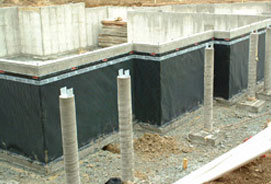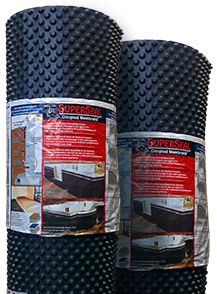Foundation Waterproofing vs. Dampproofing

Dimpled Membranes & Waterproofing vs. Dampproofing
There has always been some confusion when comparing Waterproofing vs. Dampproofing, but the International Residential Code provides some clarity.
The only exception to not have a drainage system installed in your home under the International Residential Code (I.R.C.) is “when the foundation is installed on well-drained ground or sand-gravel mixture soils”. According to the United Soil Classification System, Group I Soils, as detailed in Table R405.1. This means that all waterproofing methods are considered dampproofing, if there is no drainage system installed, unless on well-drained soil or sand; however, you may require an engineer to approve the soil. So in regards to Waterproofing vs. Dampproofing, the International Residential Code states, “Drains shall be provided around all concrete or masonry foundations that retain earth and enclose habitable or usable spaces located below grade.” SUPERSEAL Dimpled Membrane can be both dampproofing and waterproofing. When installed with a perimeter drainage system, it is considered waterproofing. When installed without a perimeter drainage system, it is considered dampproofing. So, this is true for all Waterproofing vs. Dampproofing applications for below grade foundation coatings or membranes under the I.R.C.
The SUPERSEAL Solution:
According to the I.R.C., when it comes to waterproofing vs. dampproofing, SUPERSEAL Dimpled Membrane is considered both. SUPERSEAL Dimpled Membrane has countless benefits, but the most important is its ability to let your home breathe. SUPERSEAL 24-mil high-density membrane not only keeps external water out but it also allows internal moisture to escape to the footing drain for removal. It also removes 100% of the hydro-static head-water pressure off the face of the wall and is unaffected by alkaline in soils and concrete.






